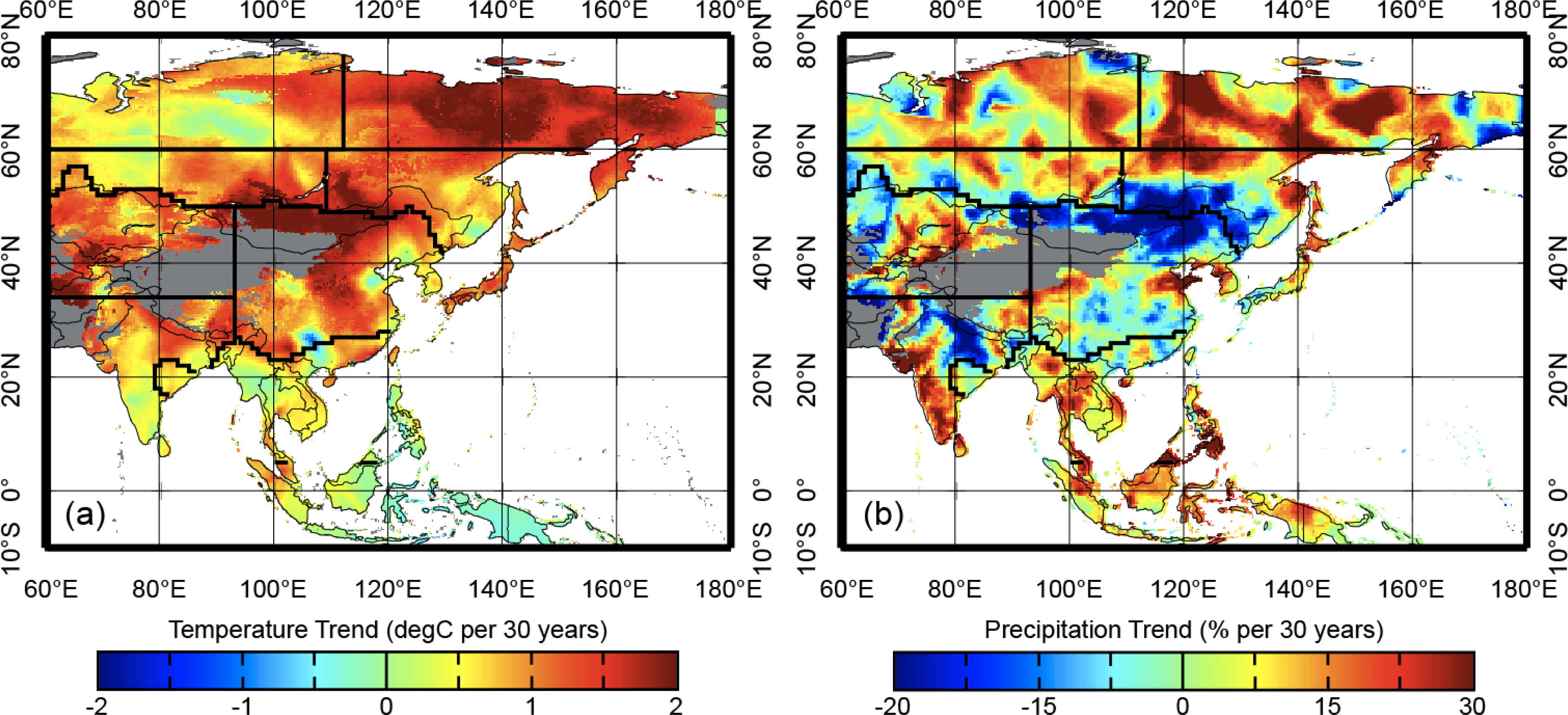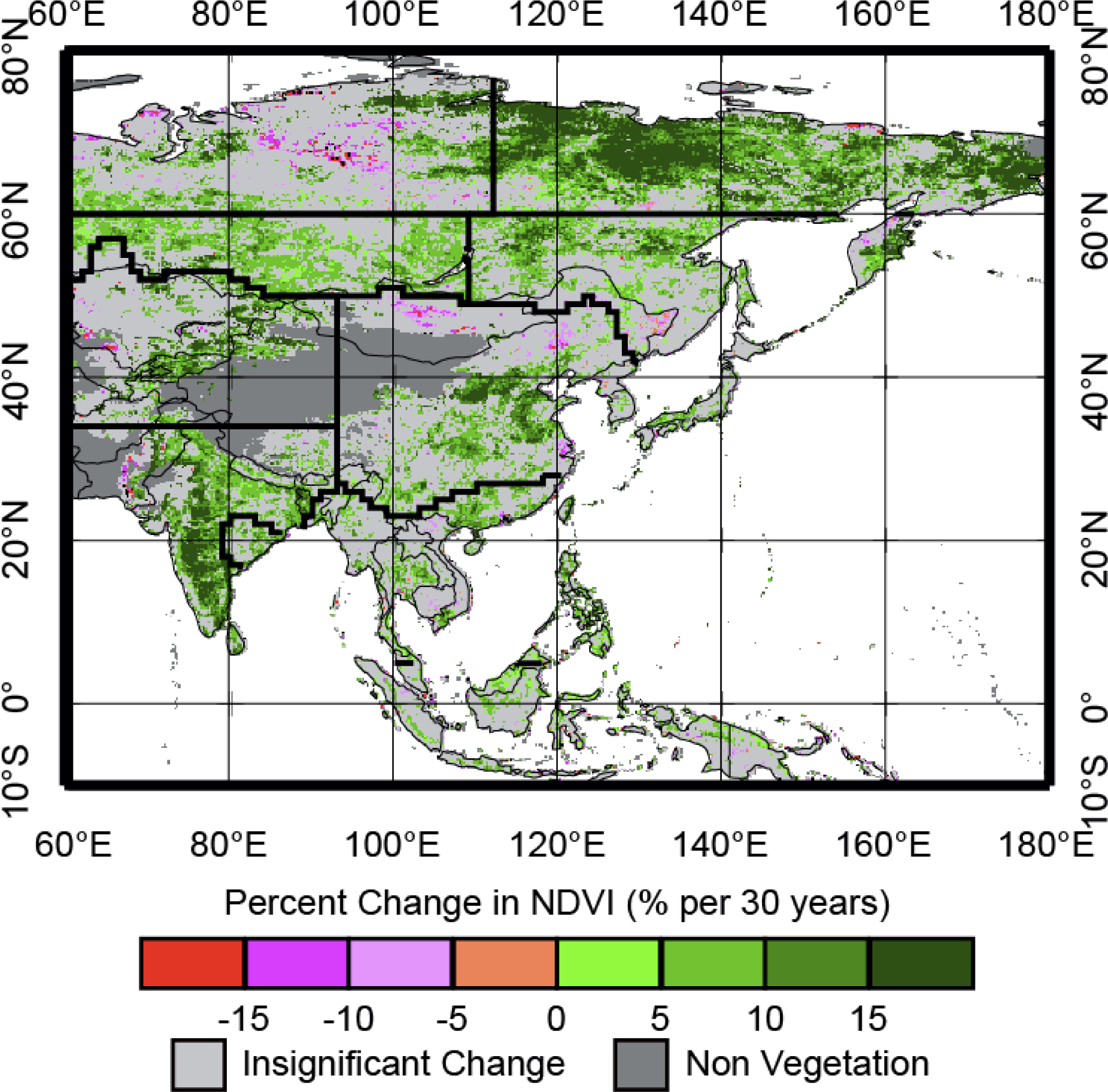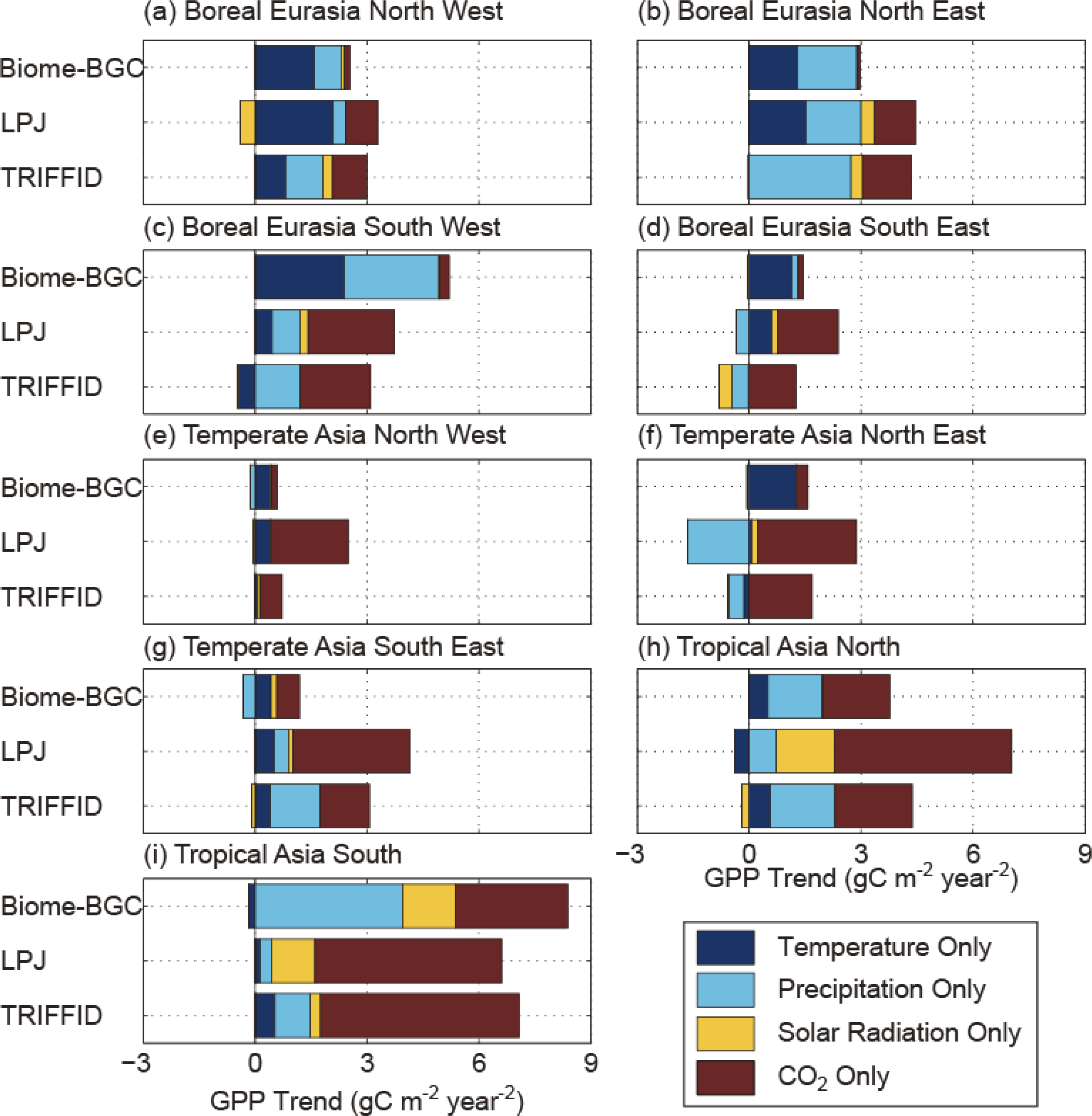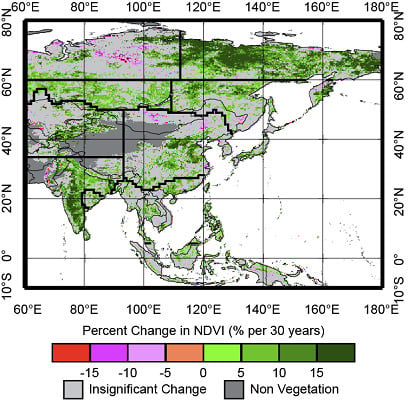Recent Changes in Terrestrial Gross Primary Productivity in Asia from 1982 to 2011
Abstract
:1. Introduction
2. Materials and Methods
2.1. Study Region
2.2. Data
2.2.1. Satellite-Based Time-Series Data: NDVI, LAI, and FPAR
2.2.2. Climate Time-Series Data
2.2.3. Atmospheric CO2 Time-Series Data
2.2.4. Static Data
2.3. Terrestrial Biosphere Models
2.4. Analysis
2.4.1. Detection of the NDVI and Climate Trends from 1982 to 2011
2.4.2. Evaluation of Trends in NDVI and Modeled GPP from 1982 to 2011
2.4.3. Attribution of the Detected Changes in NDVI and GPP
3. Results and Discussion
3.1. Observed Climate and NDVI Trend for 1982–2011
3.2. Evaluation of the 30-Year Trends in NDVI and Modeled GPP
3.3. Attribution of Detected Changes in NDVI and GPP
3.4. Limitations and Potential Further Studies
4. Conclusion
Acknowledgments
Conflict of Interest
References and Notes
- Piao, S.L.; Ito, A.; Li, S.G.; Huang, Y.; Ciais, P.; Wang, X.H.; Peng, S.S.; Nan, H.J.; Zhao, C.; Ahlström, A.; et al. The carbon budget of terrestrial ecosystems in East Asia over the last two decades. Biogeosciences 2012, 9, 3571–3586. [Google Scholar]
- Patra, P.K.; Canadell, J.G.; Houghton, R.A.; Piao, S.L.; Oh, N.H.; Ciais, P.; Manjunath, K.R.; Chhabra, A.; Wang, T.; Bhattacharya, T.; et al. The carbon budget of South Asia. Biogeosciences 2013, 10, 513–527. [Google Scholar]
- Dolman, A.J.; Shvidenko, A.; Schepaschenko, D.; Ciais, P.; Tchebakova, N.; Chen, T.; van der Molen, M.K.; Belelli Marchesini, L.; Maximov, T.C.; Maksyutov, S.; et al. An estimate of the terrestrial carbon budget of Russia using inventory-based, eddy covariance and inversion methods. Biogeosciences 2012, 9, 5323–5340. [Google Scholar]
- Chapin, F.S.; Sturm, M.; Serreze, M.C.; McFadden, J.P.; Key, J.R.; Lloyd, A.H.; McGuire, A.D.; Rupp, T.S.; Lynch, A.H.; Schimel, J.P.; et al. Role of land-surface changes in arctic summer warming. Science 2005, 310, 657–660. [Google Scholar]
- Le Quere, C.; Andres, R.J.; Boden, T.; Conway, T.; Houghton, R.A.; House, J.I.; Marland, G.; Peters, G.P.; van der Werf, G.R.; Ahlstrom, A.; et al. The global carbon budget 1959–2011. Earth Syst. Sci. Data 2013, 5, 165–183. [Google Scholar]
- Lepers, E.; Lambin, E.F.; Janetos, A.C.; DeFries, R.; Achard, F.; Ramankutty, N.; Scholes, R.J. A synthesis of information on rapid land-cover change for the period 1981–2000. Bioscience 2005, 55, 115–124. [Google Scholar]
- Liu, M.; Tian, H. China’s land cover and land use change from 1700 to 2005: Estimations from high-resolution satellite data and historical archives. Glob. Biogeochem. Cy. 2010, 24. [Google Scholar] [CrossRef]
- Myneni, R.B.; Keeling, C.D.; Tucker, C.J.; Asrar, G.; Nemani, R.R. Increased plant growth in the northern high latitudes from 1981 to 1991. Nature 1997, 386, 698–702. [Google Scholar]
- Zhou, L.M.; Tucker, C.J.; Kaufmann, R.K.; Slayback, D.; Shabanov, N.V.; Myneni, R.B. Variations in northern vegetation activity inferred from satellite data of vegetation index during 1981 to 1999. J. Geophys. Res 2001, 106, 20069–20083. [Google Scholar]
- Kawabata, A.; Ichii, K.; Yamaguchi, Y. Global monitoring of interannual changes in vegetation activities using NDVI and its relationships to temperature and precipitation. Int. J. Remote Sens 2001, 22, 1377–1382. [Google Scholar]
- Xiao, J.; Moody, A. Geographical distribution of global greening trends and their climatic correlates: 1982–1998. Int. J. Remote Sens 2005, 26, 2371–2390. [Google Scholar]
- Yang, F.; Ichii, K.; White, M.; Hashimoto, H.; Michaelis, A.; Votava, P.; Zhu, A.; Huete, A.; Running, S.; Nemani, R. Developing a continental-scale measure of gross primary production by combining MODIS and Ameriflux data through support vector machine approach. Remote Sens. Environ 2007, 110, 109–122. [Google Scholar]
- Beer, C.; Reichstein, M.; Tomelleri, E.; Ciais, P.; Jung, M.; Carvalhais, N.; Rodenbeck, C.; Arain, M.A.; Baldocchi, D.; Bonan, G.B.; et al. Terrestrial gross carbon dioxide uptake: Global distribution and covariation with climate. Science 2010, 329, 834–838. [Google Scholar]
- Jung, M.; Reichstein, M.; Margolis, H.A.; Cescatti, A.; Richardson, A.D.; Arain, M.A.; Arneth, A.; Bernhofer, C.; Bonal, D.; Chen, J.; et al. Global patterns of land-atmosphere fluxes of carbon dioxide, latent heat, and sensible heat derived from eddy covariance, satellite, and meteorological observations. J. Geophys. Res. 2011. [Google Scholar] [CrossRef]
- Xiao, J.; Zhuang, Q.; Law, B.E.; Chen, J.; Baldocchi, D.D.; Cook, D.R.; Oren, R.; Richardson, A.D.; Wharton, S.; Ma, S. A continuous measure of gross primary production for the conterminous United States derived from MODIS and Ameriflux data. Remote Sens. Environ 2010, 114, 576–591. [Google Scholar]
- Goetz, S.J.; Prince, S.D.; Goward, S.N.; Thawley, M.M.; Small, J. Satellite remote sensing of primary production: An improved production efficiency modeling approach. Ecol. Model 1999, 122, 239–255. [Google Scholar]
- Nemani, R.R.; Keeling, C.D.; Hashimoto, H.; Jolly, W.M.; Piper, S.C.; Tucker, C.J.; Myneni, R.B.; Running, S.W. Climate-driven increases in global terrestrial net primary production from 1982 to 1999. Science 2003, 300, 1560–1563. [Google Scholar]
- Sasai, T.; Ichii, K.; Yamaguchi, Y.; Nemani, R. Simulating terrestrial carbon fluxes using the new biosphere model “Biosphere model integrating eco-physiological and mechanistic approaches using satellite data” (BEAMS). J. Geophys. Res. 2005. [Google Scholar] [CrossRef]
- Ito, A.; Oikawa, T. A simulation model of the carbon cycle in land ecosystems (Sim-cycle): A description based on dry-matter production theory and plot-scale validation. Ecol. Model 2002, 151, 143–176. [Google Scholar]
- Sitch, S.; Smith, B.; Prentice, I.C.; Arneth, A.; Bondeau, A.; Cramer, W.; Kaplan, J.O.; Levis, S.; Lucht, W.; Sykes, M.T.; et al. Evaluation of ecosystem dynamics, plant geography and terrestrial carbon cycling in the LPJ dynamic global vegetation model. Glob. Chang. Biol 2003, 9, 161–185. [Google Scholar]
- Piao, S.; Wang, X.; Ciais, P.; Zhu, B.; Wang, T.A.O.; Liu, J.I.E. Changes in satellite-derived vegetation growth trend in temperate and boreal Eurasia from 1982 to 2006. Glob. Chang. Biol 2011, 17, 3228–3239. [Google Scholar]
- Piao, S. Interannual variations of monthly and seasonal normalized difference vegetation index (NDVI) in China from 1982 to 1999. J. Geophys. Res. 2003. [Google Scholar] [CrossRef]
- Peng, S.; Chen, A.; Xu, L.; Cao, C.; Fang, J.; Myneni, R.B.; Pinzon, J.E.; Tucker, C.J.; Piao, S. Recent change of vegetation growth trend in China. Environ. Res. Lett 2011, 6, 044027. [Google Scholar]
- Xiao, J.; Moody, A. Trends in vegetation activity and their climatic correlates: China 1982 to 1998. Int. J. Remote Sens 2004, 25, 5669–5689. [Google Scholar]
- Park, H.S.; Sohn, B.J. Recent trends in changes of vegetation over East Asia coupled with temperature and rainfall variations. J. Geophys. Res. 2010. [Google Scholar] [CrossRef]
- Jeong, S.-J.; Ho, C.-H.; Jeong, J.-H. Increase in vegetation greenness and decrease in springtime warming over East Asia. Geophys. Res. Lett. 2009. [Google Scholar] [CrossRef]
- Nagai, S.; Ichii, K.; Morimoto, H. Interannual variations in vegetation activities and climate variability caused by ENSO in tropical rainforests. Int. J. Remote Sens 2007, 28, 1285–1297. [Google Scholar]
- Bala, G.; Joshi, J.; Chaturvedi, R.; Gangamani, H.; Hashimoto, H.; Nemani, R. Trends and variability of AVHRR-derived NPP in India. Remote Sens 2013, 5, 810–829. [Google Scholar]
- Milesi, C.; Samanta, A.; Hashimoto, H.; Kumar, K.K.; Ganguly, S.; Thenkabail, P.S.; Srivastava, A.N.; Nemani, R.R.; Myneni, R.B. Decadal variations in NDVI and food production in India. Remote Sens 2010, 2, 758–776. [Google Scholar]
- Saigusa, N.; Ichii, K.; Murakami, H.; Hirata, R.; Asanuma, J.; Den, H.; Han, S.-J.; Ide, R.; Li, S.-G.; Ohta, T.; et al. Impact of meteorological anomalies in the 2003 summer on gross primary productivity in East Asia. Biogeosciences 2010, 7, 641–655. [Google Scholar]
- Piao, S.; Fang, J.; Zhou, L.; Zhu, B.; Tan, K.; Tao, S. Changes in vegetation net primary productivity from 1982 to 1999 in China. Glob. Biogeochem. Cy. 2005. [Google Scholar] [CrossRef]
- Lucht, W.; Prentice, I.C.; Myneni, R.B.; Sitch, S.; Friedlingstein, P.; Cramer, W.; Bousquet, P.; Buermann, W.; Smith, B. Climatic control of the high-latitude vegetation greening trend and Pinatubo effect. Science 2002, 296, 1687–1689. [Google Scholar]
- Hashimoto, H.; Melton, F.; Ichii, K.; Milesi, C.; Wang, W.; Nemani, R.R. Evaluating the impacts of climate and elevated carbon dioxide on tropical rainforests of the western Amazon basin using ecosystem models and satellite data. Glob. Chang. Biol 2010, 16, 255–271. [Google Scholar]
- Piao, S.; Friedlingstein, P.; Ciais, P.; Zhou, L.; Chen, A. Effect of climate and CO2 changes on the greening of the northern hemisphere over the past two decades. In Geophys. Res. Lett.; 2006. [Google Scholar] [CrossRef]
- Friedl, M.A.; Sulla-Menashe, D.; Tan, B.; Schneider, A.; Ramankutty, N.; Sibley, A.; Huang, X. MODIS collection 5 global land cover: Algorithm refinements and characterization of new datasets. Remote Sens. Environ 2010, 114, 168–182. [Google Scholar]
- Takagi, H.; Saeki, T.; Oda, T.; Saito, M.; Valsala, V.; Belikov, D.; Saito, R.; Yoshida, Y.; Morino, I.; Uchino, O.; et al. On the benefit of GOSAT observations to the estimation of regional CO2 fluxes. Sola 2011, 7, 161–164. [Google Scholar]
- Tucker, C.; Pinzon, J.; Brown, M.; Slayback, D.; Pak, E.; Mahoney, R.; Vermote, E.; El Saleous, N. An extended AVHRR 8-km NDVI dataset compatible with MODIS and SPOT VEGETATION NDVI data. Int. J. Remote Sens 2005, 26, 4485–4498. [Google Scholar]
- Pinzon, J.E. Revisiting error, precision and uncertainty in NDVI AVHRR data: Development of a consistent NDVI3g time series. Remote Sens. in preparation..
- Veroustraete, F.; Patyn, J.; Myneni, R.B. Estimating net ecosystem exchange of carbon using the normalized difference vegetation index and an ecosystem model. Remote Sens. Environ 1996, 58, 115–130. [Google Scholar]
- Zhu, Z.; Bi, J.; Pan, Y.; Ganguly, S.; Anav, A.; Xu, L.; Samanta, A.; Piao, S.; Nemani, R.; Myneni, R. Global data sets of vegetation leaf area index (LAI)3g and fraction of photosynthetically active radiation (FPAR)3g derived from global inventory modeling and mapping studies (GIMMS) normalized difference vegetation index (NDVI3g) for the period 1981 to 2011. Remote Sens 2013, 5, 927–948. [Google Scholar]
- Sasai, T.; Okamoto, K.; Hiyama, T.; Yamaguchi, Y. Comparing terrestrial carbon fluxes from the scale of a flux tower to the global scale. Ecol. Model 2007, 208, 135–144. [Google Scholar]
- Myneni, R.B.; Hoffman, S.; Knyazikhin, Y.; Privette, J.L.; Glassy, J.; Tian, Y.; Wang, Y.; Song, X.; Zhang, Y.; Smith, G.R.; et al. Global products of vegetation leaf area and fraction absorbed PAR from year one of MODIS data. Remote Sens. Environ 2002, 83, 214–231. [Google Scholar]
- Yuan, H.; Dai, Y.; Xiao, Z.; Ji, D.; Shangguan, W. Reprocessing the MODIS leaf area index products for land surface and climate modelling. Remote Sens. Environ 2011, 115, 1171–1187. [Google Scholar]
- CRUNCEP Data Set. Available online: http://nacp.ornl.gov/thredds/fileServer/reccapDriver/cru_ncep/analysis/readme.htm (accessed on 13 November 2013).
- Harris, I.; Jones, P.D.; Osborn, T.J.; Lister, D.H. Updated high-resolution grids of monthly climatic observations - the CRUTS3.10 dataset. Int. J. Climatol. 2013. [Google Scholar] [CrossRef]
- Kalnay, E.; Kanamitsu, M.; Kistler, R.; Collins, W.; Deaven, D.; Gandin, L.; Iredell, M.; Saha, S.; White, G.; Woollen, J.; et al. The NCEP/NCAR 40-year reanalysis project. Bull. Am. Meteorol. Soc 1996, 77, 437–471. [Google Scholar]
- Thornton, P.E.; Running, S.W. An improved algorithm for estimating incident daily solar radiation from measurements of temperature, humidity, and precipitation. Agric. For. Meteorol 1999, 93, 211–228. [Google Scholar]
- Frouin, R.; Murakami, H. Estimating photosynthetically available radiation at the ocean surface from ADEOS-II Global Imager data. J. Oceanogr 2007, 63, 493–503. [Google Scholar]
- Trends in Atmospheric Carbon Dioxide. Available online: http://www.esrl.noaa.gov/gmd/ccgg/trends/ (accessed on 13 October 2013).
- Historical CO2 Records from the Law Dome DE08, DE08–2, and DSS Ice Cores. Available online: http://cdiac.ornl.gov/trends/co2/lawdome.html (accessed on 13 October 2013).
- Global 30 Arc-Second Elevation (GTOPO30). Available online: https://lta.cr.usgs.gov/GTOPO30 (accessed on 13 October 2013).
- Schenk, H.J.; Jackson, R.B. ISLSCL II Ecosystem Rooting Depths; Oak Ridge National Laboratory Distributed Active Archive Center: Oak Ridge, TN, USA, 2009. [Google Scholar]
- Thornton, P.E.; Law, B.E.; Gholz, H.L.; Clark, K.L.; Falge, E.; Ellsworth, D.S.; Goldstein, A.H.; Monson, R.K.; Hollinger, D.; Falk, M.; et al. Modeling and measuring the effects of disturbance history and climate on carbon and water budgets in evergreen needleleaf forests. Agric. For. Meteorol 2002, 113, 185–222. [Google Scholar]
- Gerten, D.; Schaphoff, S.; Haberlandt, U.; Lucht, W.; Sitch, S. Terrestrial vegetation and water balance—hydrological evaluation of a dynamic global vegetation model. J. Hydrol 2004, 286, 249–270. [Google Scholar]
- Cox, P. Description of the “TRIFFID” Dynamic Global Vegetation Model; Hadley Center: Exeter, UK, 2001. [Google Scholar]
- Suzuki, T.; Ichii, K. Evaluation of a terrestrial carbon cycle submodel in an earth system model using networks of eddy covariance observations. Tellus B 2010, 62, 729–742. [Google Scholar]
- Farquhar, G.D.; Caemmerer, V.; Berry, J.A. A biochemical model of phytosynthetic CO2 assimilation in leaves of C3 species. Planta 1980, 149, 78–90. [Google Scholar]
- Collatz, G.; Ball, J.T.; Grivet, C.; Berry, J.A. Physiological and environmental regulation of stomatal conductance, photosynthesis and transpiration: A model that includes a laminar boundary layer. Agric. For. Meteorol 1991, 54, 107–136. [Google Scholar]
- Ball, J.T.; Woodrow, I.E.; Berry, J.A. A Model Predicting Stomatal Conductance and Its Contribution to the Control of Photosynthesis under Different Environmental Conditions. In Progress in Photosynthesis Research; Biggins, J., Ed.; Marinus Nijhoff: Leiden, The Netherlands, 1987; Volume 4, pp. 221–224. [Google Scholar]
- Leuning, R. Modelling stomatal behavior and photosynthesis of eucalyptus grandis. Aust. J. Plant Physiol 1990, 17, 159–175. [Google Scholar]
- Jarvis, P.G. The interpretation of the variations in leaf water potential and stomatal conductance found in canopies in the field. Philos. Trans. R. Soc. B-Biol. Sci 1976, 273, 593–610. [Google Scholar]
- Haxeltine, A.; Prentice, I.C. BIOME3: An equilibrium terrestrial biosphere model based on ecophysiological constraints, resource availability, and competition among plant functional types. Glob. Biogeochem. Cy 1996, 10, 693–709. [Google Scholar]
- Collatz, G.; Ribas-Carbo, M.; Berry, J. Coupled photosynthesis-stomatal conductance model for leaves of C4 plants. Aust. J. Plant Physiol 1992, 19, 519–538. [Google Scholar]
- Cox, P.M.; Betts, R.A.; Bunton, C.B.; Essery, R.L.H.; Rowntree, P.R.; Smith, J. The impact of new land surface physics on the GCM simulation of climate and climate sensitivity. Clim. Dyn 1999, 15, 183–203. [Google Scholar]
- Ichii, K.; Hashimoto, H.; Nemani, R.; White, M. Modeling the interannual variability and trends in gross and net primary productivity of tropical forests from 1982 to 1999. Glob. Planet. Chang 2005, 48, 274–286. [Google Scholar]
- Kendall, M.G. A new measure of rank correlation. Biometrika 1938, 30, 81–93. [Google Scholar]
- Sokal, R.R.; Rohlf, F.J. Biometry: The Principles and Practice of Statistics in Biological Research, 3rd ed; W.H. Freeman: New York, NY, USA, 1995; p. 539. [Google Scholar]
- Kobayashi, H.; Dye, D.G. Atmospheric conditions for monitoring the long-term vegetation dynamics in the Amazon using normalized difference vegetation index. Remote Sens. Environ 2005, 97, 519–525. [Google Scholar]
- Ichii, K.; Kondo, M.; Lee, Y.-H.; Wang, S.-Q.; Kim, J.; Ueyama, M.; Lim, H.-J.; Shi, H.; Suzuki, T.; Ito, A.; et al. Site-level model—Data synthesis of terrestrial carbon fluxes in the CarboEastAsia eddy-covariance observation network: Toward future modeling efforts. J. For. Res 2013, 18, 13–20. [Google Scholar]
- Ichii, K.; Hashimoto, H.; White, M.A.; Potters, C.; Hutyra, L.R.; Huete, A.R.; Myneni, R.B.; Nemanis, R.R. Constraining rooting depths in tropical rainforests using satellite data and ecosystem modeling for accurate simulation of gross primary production seasonality. Glob. Chang. Biol 2007, 13, 67–77. [Google Scholar]
- Piao, S.; Sitch, S.; Ciais, P.; Friedlingstein, P.; Peylin, P.; Wang, X.; Ahlstrom, A.; Anav, A.; Canadell, J.G.; Cong, N.; et al. Evaluation of terrestrial carbon cycle models for their response to climate variability and to CO2 trends. Glob. Chang. Biol 2013, 19, 2117–2132. [Google Scholar]
- Ichii, K.; Suzuki, T.; Kato, T.; Ito, A.; Hajima, T.; Ueyama, M.; Sasai, T.; Hirata, R.; Saigusa, N.; Ohtani, Y.; et al. Multi-model analysis of terrestrial carbon cycles in Japan: Limitations and implications of model calibration using eddy flux observations. Biogeosciences 2010, 7, 2061–2080. [Google Scholar]
- Schwalm, C.R.; Williams, C.A.; Schaefer, K.; Anderson, R.; Arain, M.A.; Baker, I.; Barr, A.; Black, T.A.; Chen, G.; Chen, J.M.; et al. A model-data intercomparison of CO2 exchange across North America: Results from the North American Carbon Program site synthesis. J. Geophys. Res. 2010. [Google Scholar] [CrossRef]
- Jung, M.; le Maire, G.; Zaehle, S.; Luyssaert, S.; Vetter, M.; Churkina, G.; Ciais, P.; Viovy, N.; Reichstein, M. Assessing the ability of three land ecosystem models to simulate gross carbon uptake of forests from boreal to mediterranean climate in Europe. Biogeosciences 2007, 4, 647–656. [Google Scholar]
- Saigusa, N.; Li, S.-G.; Kwon, H.; Takagi, K.; Zhang, L.-M.; Ide, R.; Ueyama, M.; Asanuma, J.; Choi, Y.-J.; Chun, J.H.; et al. Dataset of CarboEastAsia and uncertainties in the CO2 budget evaluation caused by different data processing. J. For. Res 2013, 18, 41–48. [Google Scholar]
- SRB Data and Information. Available online: https://eosweb.larc..nasa.gov/project/srb/srb_table (accessed on 13 October 2013).





| Region | NDVI | BEAMS | Biome-BGC | LPJ | TRIFFID |
|---|---|---|---|---|---|
| Boreal Eurasia North West | 0.015 | 0.5 (2.5) | 2.4 (9.2) ** | 3.2 (11.8) ** | 3.8** (14.6) |
| Boreal Eurasia North East | 0.068** | 1.3 (5.3) ** | 3.6 (14.7) ** | 5.0 (19.6) ** | 5.7** (21.1) |
| Boreal Eurasia South West | 0.041** | 1.9 (5.5) ** | 5.9 (16.5) ** | 5.5 (15.3) ** | 3.5** (9.2) |
| Boreal Eurasia South East | 0.034** | 1.8 (6.2) ** | 1.9 (6.1) ** | 3.4 (11.4) ** | 0.8 (2.5) |
| Temperate Asia North West | 0.024** | 1.4 (4.6) ** | 0.6 (2.3) * | 2.9 (9.3) * | 0.9** (3.0) |
| Temperate Asia North East | 0.020** | 1.7 (11.8) ** | 2.5 (17.8) ** | 1.3 (9.9) * | 1.4* (11.2) |
| Temperate Asia South East | 0.032** | 3.7 (15.5) ** | 0.9 (4.1) ** | 4.2 (17.4) ** | 2.7** (11.6) |
| Tropical Asia North | 0.023* | 5.1 (21.2) ** | 6.6 (27.2) ** | 7.1 (29.9) ** | 4.5** (18.9) |
| Tropical Asia South | 0.013 | 3.0 (11.9) ** | 11.8 (46.0) ** | 7.9 (30.8) ** | 7.9** (30.9) |
| Region | BEAMS | Biome-BGC | LPJ | TRIFFID |
|---|---|---|---|---|
| Boreal Eurasia North West | 0.67** | 0.31* | 0.50** | 0.33* |
| Boreal Eurasia North East | 0.72** | 0.70** | 0.66** | 0.68** |
| Boreal Eurasia South West | 0.80** | 0.40** | 0.37** | 0.16 |
| Boreal Eurasia South East | 0.71** | 0.45** | 0.46** | 0.37** |
| Temperate Asia North West | 0.83** | 0.49** | 0.51** | 0.57** |
| Temperate Asia North East | 0.76** | 0.44** | 0.44** | 0.39** |
| Temperate Asia South East | 0.74** | 0.54** | 0.55** | 0.48** |
| Tropical Asia North | 0.58** | 0.27* | 0.23 | 0.20 |
| Tropical Asia South | 0.17 | 0.26* | 0.16 | 0.17 |
© 2013 by the authors; licensee MDPI, Basel, Switzerland This article is an open access article distributed under the terms and conditions of the Creative Commons Attribution license ( http://creativecommons.org/licenses/by/3.0/).
Share and Cite
Ichii, K.; Kondo, M.; Okabe, Y.; Ueyama, M.; Kobayashi, H.; Lee, S.-J.; Saigusa, N.; Zhu, Z.; Myneni, R.B. Recent Changes in Terrestrial Gross Primary Productivity in Asia from 1982 to 2011. Remote Sens. 2013, 5, 6043-6062. https://doi.org/10.3390/rs5116043
Ichii K, Kondo M, Okabe Y, Ueyama M, Kobayashi H, Lee S-J, Saigusa N, Zhu Z, Myneni RB. Recent Changes in Terrestrial Gross Primary Productivity in Asia from 1982 to 2011. Remote Sensing. 2013; 5(11):6043-6062. https://doi.org/10.3390/rs5116043
Chicago/Turabian StyleIchii, Kazuhito, Masayuki Kondo, Yuki Okabe, Masahito Ueyama, Hideki Kobayashi, Seung-Jae Lee, Nobuko Saigusa, Zaichun Zhu, and Ranga B. Myneni. 2013. "Recent Changes in Terrestrial Gross Primary Productivity in Asia from 1982 to 2011" Remote Sensing 5, no. 11: 6043-6062. https://doi.org/10.3390/rs5116043
APA StyleIchii, K., Kondo, M., Okabe, Y., Ueyama, M., Kobayashi, H., Lee, S.-J., Saigusa, N., Zhu, Z., & Myneni, R. B. (2013). Recent Changes in Terrestrial Gross Primary Productivity in Asia from 1982 to 2011. Remote Sensing, 5(11), 6043-6062. https://doi.org/10.3390/rs5116043







